Summary of functions
When driving on roads with white (yellow) lines, this function alerts the
driver when the vehicle might depart from its lane.
The LDA system recognizes visible
white (yellow) lines with the
camera sensor on the upper portion
of the windshield.
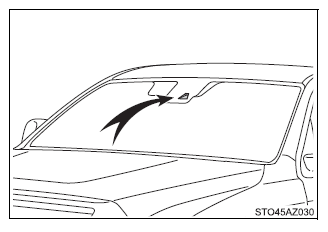
Functions included in LDA system
Lane departure alert function
When the system determines
that the vehicle might depart
from its lane, a warning is displayed
on the multi-information
display and the warning buzzer
sounds to alert the driver.
When the warning buzzer
sounds, check the surrounding
road situation and carefully
operate the steering wheel to
move the vehicle back to the
center of the lane.
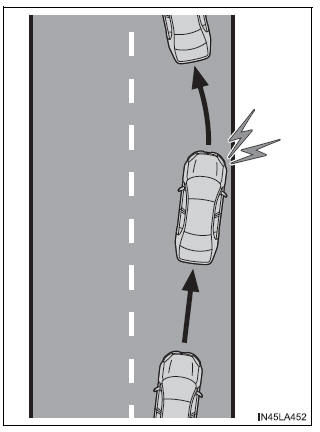
Vehicle sway warning
When the vehicle is swaying or
appears as if it may depart from
its lane multiple times, the
warning buzzer sounds and a
message is displayed on the
multi-information display to alert
the driver.
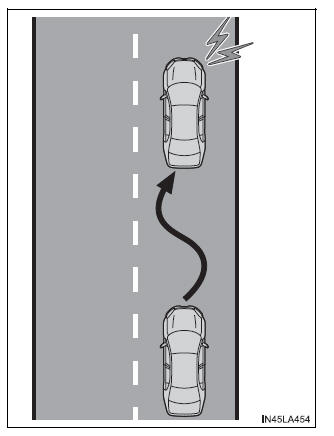
| WARNING ■Before using LDA system
Do not rely solely upon the LDA system. The LDA system does not
automatically
drive the vehicle or reduce the amount of attention that must be
paid to the area in front of the vehicle. The driver must always assume
full
responsibility for driving safely by always paying careful attention to
the surrounding
conditions and operating the steering wheel to correct the path of
the vehicle. Also, the driver must take adequate breaks when fatigued,
such
as from driving for a long period of time.
Failure to perform appropriate driving operations and pay careful
attention
may lead to an accident, resulting in death or serious injury.
■To avoid operating LDA system by mistake
When not using the LDA system, use the LDA switch to turn the system
off.
■Situations unsuitable for LDA system
Do not use the LDA system in the following situations.
The system may not operate properly and lead to an accident, resulting
in
death or serious injury.
- A spare tire, tire chains, etc., are equipped.
- Objects or patterns that could be mistaken for white (yellow)
lines are
present on the side of the road (guardrails, curbs, reflective
poles, etc.).
- Vehicle is driven on a snow-covered road.
- White (yellow) lines are difficult to see due to rain, snow,
fog, dust, etc.
- Asphalt repair marks, white (yellow) line marks, etc., are
present due to
road repair.
- Vehicle is driven in a temporary lane or restricted lane due to
construction
work.
- Vehicle is driven in a construction zone.
|
| WARNING ■Preventing LDA system malfunctions and
operations performed by
mistake
- Do not modify the headlights or place stickers, etc., on the
surface of the
lights.
- Do not modify the suspension, etc. If the suspension, etc.,
needs to be
replaced, contact your Toyota dealer.
- Do not install or place anything on the hood or grille. Also, do
not install a
grille guard (bull bars, kangaroo bar, etc.).
- If your windshield needs repairs, contact your Toyota dealer.
|
Turning LDA system on
Press the LDA switch to turn the
LDA system on.
The LDA indicator illuminates and
a message is displayed on the
multi-information display.
Press the LDA switch again to turn
the LDA system off.
When the LDA system is turned on
or off, operation of the LDA system
continues in the same condition
the next time the engine is started.
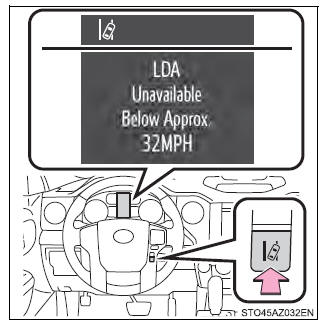
Indications on multi-information display
- LDA indicator
The illumination condition of the
indicator informs the driver of the
system operation status.
Illuminated in green:
LDA system is operating.
Flashing in yellow:
Lane departure alert function is
operating.
- Lane departure alert function
display
Displayed when the multi-information
display is switched to the driving
assist system information
screen.
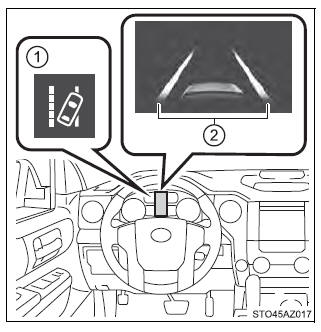
Inside of displayed white lines
is white
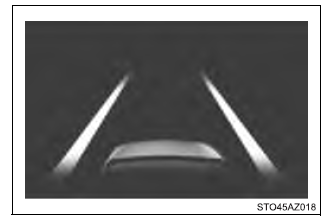
Indicates that the system is recognizing
white (yellow) lines. When
the vehicle departs from its lane,
the white line displayed on the
side the vehicle departs from
flashes orange.
Inside of displayed white lines
is black
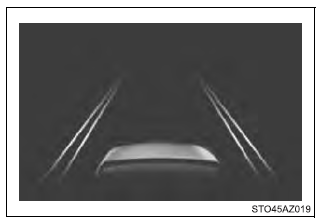
Indicates that the system is not
able to recognize white (yellow)
lines or is temporarily canceled.
■Operation conditions of each function
- Lane departure alert function
This function operates when all of the following conditions are met.
- LDA is turned on.
- Vehicle speed is approximately 32 mph (50 km/h) or more.
- System recognizes white (yellow) lines.
- Width of traffic lane is approximately 9.8 ft. (3 m) or more.
- Turn signal lever is not operated.
- Vehicle is driven on a straight road or around a gentle curve with a
radius
of more than approximately 492 ft. (150 m).
- No system malfunctions are detected.
- Vehicle sway warning function
This function operates when all of the following conditions are met.
- Setting for
 " Warning"
in " Warning"
in  screen of the
multi-information display is
set to on. screen of the
multi-information display is
set to on.
- Vehicle speed is approximately 32 mph (50 km/h) or more.
- Width of traffic lane is approximately 9.8 ft. (3 m) or more.
- No system malfunctions are detected.
■Temporary cancellation of functions
When the operation conditions are no longer met, a function may be
temporarily
canceled. However, when the operation conditions are met again, operation
of the function is automatically restored.
■Lane departure alert function
The warning buzzer may be difficult to hear due to external noise, audio
playback,
etc.
■Vehicle sway warning function When the system determines that the
vehicle is swaying while the vehicle sway
warning function is operating, a buzzer
sounds and a warning message urging
the driver to rest and the symbol shown in
the illustration are simultaneously displayed
on the multi-information display.
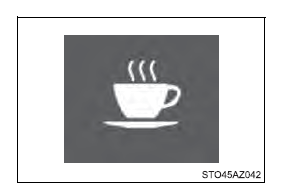
Depending on the vehicle and road conditions, the warning may not operate.
■White (yellow) lines are only on one side of road
The LDA system will not operate for the side on which white (yellow) lines
could not be recognize
■Conditions in which functions may not operate properly
In the following situations, the camera sensor may not detect white (yellow)
lines and various functions may not operate normally.
- There are shadows on the road that run parallel with, or cover, the
white
(yellow) lines.
- The vehicle is driven in an area without white (yellow) lines, such as
in front
of a tollgate or checkpoint, or at an intersection, etc.
- The white (yellow) lines are cracked, "Botts' dots", "Raised pavement
marker" or stones are present.
- The white (yellow) lines cannot be seen or are difficult to see due to
sand,
etc.
- The vehicle is driven on a road surface that is wet due to rain,
puddles, etc.
- The traffic lines are yellow (which may be more difficult to recognize
than
lines that are white).
- The white (yellow) lines cross over a curb, etc.
- The vehicle is driven on a bright surface, such as concrete.
- The vehicle is driven on a surface that is bright due to reflected
light, etc.
- The vehicle is driven in an area where the brightness changes suddenly,
such as at the entrances and exits of tunnels, etc.
- Light from the headlights of an oncoming vehicle, the sun, etc., enters
the
camera.
- The vehicle is driven where the road diverges, merges, etc.
- The vehicle is driven on a slope.
- The vehicle is driven on a road which tilts left or right, or a winding
road.
- The vehicle is driven on an unpaved or rough road.
- The vehicle is driven around a sharp curve.
- The traffic lane is excessively narrow or wide.
- The vehicle is extremely tilted due to carrying heavy luggage or having
improper tire pressure.
- The distance to the preceding vehicle is extremely short.
- The vehicle is moving up and down a large amount due to road conditions
during driving (poor roads or road seams).
- The headlight lenses are dirty and emit a faint amount of light at
night, or the
beam axis has deviated.
- The vehicle has just changed lanes or crossed an intersection.
■Warning message
Warning messages are used to indicate a system malfunction or to inform the
driver of the need for caution while driving.
■Customization
The following settings can be changed.
| Function |
Setting details |
| Lane departure alert function |
Adjust alert sensitivity |
| Vehicle sway warning |
Turn function on and off |
| Adjust alert sensitivity |
|